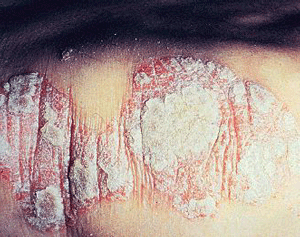psoro-, psor- +
(Greek: itch, mange)
2. An antipsoric remedy.
2. A chronic dermatosis of unknown origin, with erythematous, papular, and scaling lesions appearing in persistent and often enlarging plaques.
3. Any of a group of slowly evolving erythrodermas having common characteristics of scaling, resistance to treatment, and chronicity. The group includes acute and chronic lichenoid pityriasis and large and small plaque parapsoriasis.
4. A heterogenous group of skin disorders including pityriasis lichenoides and small and large plaque variants.
2. An eruption of small, isolated, acuminated vesicles, produced by the entrance of a parasitic mite (the Sarcoptes scabei), and attended with itching. It is transmissible by contact.
3. Any itching eruption.
4. A sensation in the skin occasioned (or resembling that occasioned) by an itch eruption; also called, scabies.
Scabies is a transmissible ectoparasite skin infection characterized by superficial burrows, intense pruritus (itching) and secondary infection. The word scabies is Latin for "itch".
2. A chronic skin disease characterized by circumscribed red patches covered with white scales.
3. A noncontagious inflammatory skin disease characterized by recurring reddish patches covered with silvery scales.
4. The cause of the disease is unknown, but a genetic predisposition is apparent.
5. Etymology: first recorded in 1684, from Late Latin psoriasis, "mange, scurvy", which came from Greek psoriasis, "being itchy"; from psorian, "to have the itch"; from psora, "itch"; related to psen "to rub".
A medical "clarification" for greater "understanding"
A common chronic, squamous dermatosis, marked by exacerbations and remissions and having a polygenic inheritance pattern. The most distinctive histological findings in well developed psoriasis are Munro microabscesses and spongiform pustules.
It is characterised clinically by the presence of rounded, circumscribed, erythematous, dry scaling patches of various sizes, covered by greyish white or silvery white, umbilicated and lamellar scales, which have a predilection for the extensor surfaces, nails, scalp, genitalia and lumbosacral region.
Central clearing and coalescence of the lesions produce a wide variety of clinical configurations, including annular, or circinate, discoid or nummular, figurate and gyrate arrangements.

![]() Here is much more information about psoriasis.
Here is much more information about psoriasis.
2. A person affected with psoriasis.
It is a serious pest in some areas, the adult mites spreading from sheep to sheep. Damage to the fleece results from the irritation which causes the host to scratch, rub, and bite affected parts of the body.
2. Inflammation of the eyelids of sufficient severity to cause local areas of tissue necrosis; blepharitis ulcerosa.
Cross references directly, or indirectly, involving the "skin": callus-; chorio-; cicatri- (scar); cori-; cuti-; hymen-; lepido- (scab, scale); papulo- (pimple); pustu- (blister, pimple); rhytid- (wrinkle); scabio- (mange, itchy); sebo- (grease, oil).
